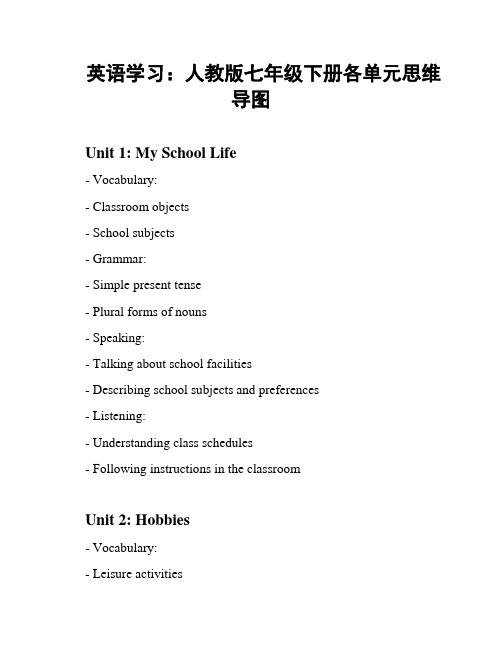【思维导图】英文模板-V4zonBnb_La-Seconde-Guerre-Mondiale-脑图
【初中英语语法】50张思维导图,学会英语语法!

【初中英语语法】50张思维导图,学会英语语法!温馨提示▼1. 点击文末左下方“阅读原文”,获取其他文章微课堂▼知识汇总英语语法的丛林,横斜逸出,纵横交错,光用文字来描述,是太无力低效的,如何理清这一段段关系,勾画出其中的复杂关系,直观地看清这一切,答曰:思维导图也。
以下思维导图多为树状,我们也称之为“英语语法知识树”,曾经我受益匪浅,今天分享给大家,希望你也如此!50个语法树请收好。
1.中学英语语法知识体系2.英语能力树3. 英语学习习惯4. 单词记忆通用工具5. 英语整体建构课堂教学模式6. “和谐教育整体建构教学法”7. 中学英语16种时态8. 名词I9. 名词II10. 冠词11. 数词12. 代词的分类13. 人称代词14. 物主代词15. 反身代词16.指示代词17. 疑问代词18. 关系代词19.不定代词20. 形容词21. 副词22.形容词和副词的比较等级23. 有关比较级的区别24. 动词25. 常见助动词用法26. 助动词27. 非谓语动词28. 动词ing形式29. 不定式的时态和语态30. 省to 的动词不定式31. 不定式作宾语32. 不定式作补语33. 不定式作主语34. 不定式句法功能35. doing与to do的区别136. doing与to do的区别237.分词38.独立主格结构39.一般现在时40.一般将来时41.现在完成时42.一般过去时43.现在进行时44.时态与时间状语45. 被动语态46. 各种形式的被动语态47.句子的种类48.反意疑问句49.反意疑问句记忆规则150.反意疑问句记忆规则2 -End-。
英语思维导图模板

英语思维导图模板思维导图是一种视觉化的思考工具,可以帮助我们整理思路、记录信息、制定计划、解决问题等,同时也是英语学习中非常实用的工具。
以下是一个英语思维导图模板,可供参考。
1. Vocabulary- Nouns- Common nouns- Proper nouns- Verbs- Action verbs- Helping verbs- Adjectives- Adverbs- Prepositions- Conjunctions- Pronouns2. Grammar- Parts of speech- Tenses- Modal verbs- Conditionals- Passive voice- Reported speech- Phrasal verbs- Idioms3. Reading- Skimming- Scanning- Active reading- Identifying main ideas- Finding supporting details- Making inferences- Analyzing author's purpose- Understanding tone and mood - Recognizing literary devices4. Writing- Types of writing- Narrative- Descriptive- Expository- Persuasive- Writing process- Planning- Drafting- Revising- Editing- Publishing- Structure of writing- Introduction- Body- Conclusion- Grammar and punctuation5. Speaking- Introducing oneself- Making small talk- Asking for and giving information- Expressing opinions and preferences- Giving instructions- Describing things and people- Narrating events- Making suggestions and recommendations - Negotiating and compromising6. Listening- Understanding spoken English- Identifying main points- Recognizing nuances and idiomatic expressions- Differentiating accents and dialects- Taking notes- Summarizing information- Responding appropriately7. Culture- American and British cultures- Customs and traditions- Holidays and celebrations- History and politics- Arts and entertainment- Food and drink- Everyday life以上是一个英语思维导图模板的详细内容,可以根据自己的学习需求进行适当调整和修改。
英语学习:人教版七年级下册各单元思维导图

英语学习:人教版七年级下册各单元思维导图Unit 1: My School Life- Vocabulary:- Classroom objects- School subjects- Grammar:- Simple present tense- Plural forms of nouns- Speaking:- Talking about school facilities- Describing school subjects and preferences- Listening:- Understanding class schedules- Following instructions in the classroomUnit 2: Hobbies- Vocabulary:- Leisure activities- Sports and games- Grammar:- Present continuous tense- Adverbs of frequency- Speaking:- Talking about hobbies and interests- Discussing preferences and dislikes- Listening:- Understanding conversations about hobbies- Following instructions for games and activitiesUnit 3: At Home- Vocabulary:- Rooms and furniture- Daily routines- Grammar:- Present simple tense- Prepositions of place- Speaking:- Describing rooms and houses- Talking about daily routines- Listening:- Understanding conversations about household chores - Following instructions for recipes and tasksUnit 4: Food and Drink- Vocabulary:- Types of food and drinks- Quantifiers- Grammar:- Countable and uncountable nouns- How much/How many- Speaking:- Talking about food preferences- Ordering food at a restaurant- Listening:- Understanding conversations about meals and recipes - Following instructions for cooking and servingUnit 5: Family and Friends- Vocabulary:- Family members- Personal pronouns- Grammar:- Possessive adjectives- Wh-questions- Speaking:- Introducing family members- Describing relationships- Listening:- Understanding conversations about family activities- Following instructions for interviews and introductionsUnit 6: At the Zoo- Vocabulary:- Animals and their characteristics- Adjectives to describe animals- Grammar:- There is/are- Speaking:- Talking about animals and their habitats- Listening:- Understanding conversations about zoo visits - Following directions for finding animalsUnit 7: The Weather- Vocabulary:- Weather conditions- Seasons and months- Grammar:- Present continuous for future arrangements - Adjectives to describe weather- Speaking:- Talking about weather in different seasons - Making plans based on weather forecasts- Listening:- Understanding weather reports- Following instructions for outdoor activitiesUnit 8: Holidays- Vocabulary:- Festivals and celebrations- Holiday activities- Grammar:- Past simple tense- Time expressions- Speaking:- Talking about past holidays and celebrations- Describing holiday traditions- Listening:- Understanding conversations about holiday experiences - Following instructions for crafts and gamesUnit 9: Around Town- Vocabulary:- Places in a city- Directions and locations- Grammar:- Imperatives- Giving and following directions- Speaking:- Asking for and giving directions- Describing places in a city- Listening:- Understanding conversations about city attractions - Following directions to different locationsUnit 10: Health and Fitness- Vocabulary:- Body parts and health issues- Sports and exercises- Grammar:- Present continuous for future arrangements- Imperatives for instructions- Speaking:- Talking about health and fitness routines- Giving advice on healthy habits- Listening:- Understanding conversations about health problems - Following instructions for exercises and workouts。
思维导图英语范文

思维导图英语范文1Oh my goodness! Have you ever heard of mind maps? Well, let me tell you, a mind map is an amazing tool that can truly transform the way we learn and think! It's like a magical map that helps us organize and connect our thoughts.A mind map is basically a visual representation of information. It shows the relationships between different ideas and concepts. So, what are its uses? For starters, when it comes to learning English vocabulary, we can create a mind map to group words by topics like animals, food, or emotions. This makes it so much easier to remember and recall! And when dealing with grammar, a mind map can clearly show the rules and examples, helping us understand better.Imagine preparing for an English speech or writing an essay. A mind map can be our best friend! We can start with the main idea in the center and branch out with supporting points and details. How wonderful is that? It helps us organize our thoughts logically and ensures we don't miss anything important.In conclusion, mind maps are incredibly important! They make our learning more efficient and our thinking more clear. So, why not give them a try and see the amazing results for yourself?Oh my goodness! Let me tell you about the amazing effects of mind maps in English learning. It's truly a revolutionary tool! I used to struggle with grammar and vocabulary, constantly feeling lost and confused. But then, I discovered the power of mind maps. I started organizing all the grammar rules and vocabulary words systematically on a mind map. It was like a light shining in the darkness! I could see the connections and patterns clearly.For example, my classmate Tom was also having a hard time with English composition. But after he began to use mind maps to plan his ideas and structure his essays, his writing skills improved dramatically. He went from getting average grades to being one of the top students in our class! Isn't that incredible?Another time, before an important English competition, I used a mind map to review all the key points. I included grammar, vocabulary, reading comprehension strategies, and even common mistakes to avoid. And guess what? I performed exceptionally well and won a prize. How wonderful it was!So, if you haven't tried using mind maps for English learning, you should definitely give it a go. It might just change your English learning journey forever!Oh my goodness! Let me tell you about how to create an effective mind map for English learning. Firstly, you must determine the theme. For instance, if you choose a certain English unit as the theme, like 'My School Life', then you can start to branch it out. The branches could be vocabulary, sentence patterns, grammar and so on. V ocabulary could include words like 'classroom', 'teacher', 'student'. Sentence patterns might be 'There is a blackboard in the classroom.' or 'The teacher is very kind.' And grammar, well, it could be about tenses or noun plurals.Also, don't forget to use different colors and graphics to enhance the appeal and memory effect of your mind map! Imagine using bright colors for important points and interesting graphics to represent different parts. For example, a big red star for key grammar rules or a cute apple for vocabulary related to fruits.This way, your mind map will not only be a useful tool for learning but also a beautiful and attractive creation that makes you want to look at it again and again. Isn't that wonderful? So, go ahead and create your amazing mind map for English learning!4Oh my goodness! When it comes to learning English, the differences between mind mapping and traditional learning methods are trulyremarkable. Let's take memorizing words as an example. With traditional methods, we often repeat the words over and over again, but it's so boring and ineffective! How many times have we forgotten them soon after? However, with mind mapping, we can link the words with vivid images, related phrases, and even personal experiences. It's like building a colorful and interesting world in our minds! Isn't that amazing?When it comes to understanding articles, the contrast is also striking. Traditional methods might have us mechanically analyzing sentence structures and grammar rules. But with mind mapping, we can visually represent the main ideas, supporting details, and logical connections. It helps us see the big picture clearly and understand the context better. How wonderful is that?For instance, we can combine mind mapping with flashcards. When we create a mind map of a topic, we can attach related flashcards for quick review. This combination boosts our learning efficiency and makes the learning process more enjoyable. So, why not give mind mapping a try and revolutionize our English learning journey?5Oh, dear friends! Let's think about the future of mind mapping in English education. It's truly an exciting topic!In the era of rapid technological progress, mind mapping could potentially merge with artificial intelligence. Imagine this! AI-poweredmind mapping could analyze each student's learning patterns and preferences, and then offer highly personalized English learning plans. For example, it might tailor exercises based on a student's weaknesses in grammar or vocabulary. How amazing would that be?In the context of globalization, mind mapping plays a crucial role too. Different countries have diverse cultures and educational systems, but mind mapping provides a universal tool. It helps students organize their thoughts and knowledge systematically. For instance, a student from a non-English speaking country can use mind mapping to compare and contrast the grammar structures of their native language and English. Doesn't this make the learning process more clear and effective?So, it's evident that mind mapping has a bright future in English education. It will surely continue to evolve and bring more innovative and effective ways for students to master this global language. Won't it?。
|精|高考英语必备:高中英语50张思维导图|知识点|考点|(收藏可打印)

高考英语必备:高中英语50 张思维导图1. 中学英语语法知识体系2. 英语能力树3. 英语学习习惯4. 单词记忆通用工具5. 英语整体建构课堂教学模式6. “和谐教育整体建构教学法7. 中学英语16 种时态8. 名词II9. 名词II10. 冠词11. 数词12. 代词的分类13. 人称代词14. 物主代词15. 反身代词16. 指示代词17. 疑问代词18. 关系代词19. 不定代词20. 形容词21. 副词22. 形容词和副词的比较等级23. 有关比较级的区别24. 动词25. 常见助动词用法26. 助动词27. 非谓语动词28. 动词ing 形式29. 不定式的时态和语态30. 省to 的动词不定式31. 不定式作宾语de<Sand^] !determine jIaPPe r rl阿可鬥血可 叵叵可|如血∣ E lrTmIIrSrl Ie 佃"I h∙g I[expect ] h&W ] Ih jB h ] E亦 I InXd IPwl "b∙∣ w⅛h '∣两皿I IPetnZ ]卩哪叽∣h∙∙ltattt] P"rn[ E"rι I ^ana g aI OfTer ] ⅛oug^∣ Pian I 丽輔 E ] hoos0I nt∙ndp∙ncl br«mise 'infuse ∣WaltUncIertakeIUfIderYtdrld Ii r ememberb⅝r<κt∣ Iaycaw IdareJdecideOnSiderWCn-Cier 1 叵¢1 OUt ∣∣IearnReJI ] N∙τ I ∣∙)cpl∙i>⅝ ]ShOW^ΛUtrSee卜now32.不定式作补语33. 不定式作主语34. 不定式句法功能35. doing 与to do 的区别136. doing 与to do 的区别137. 分词38. 独立主格结构39. 一般现在时40. 一般将来时41. 现在完成时42. 一般过去时43. 现在进行时44. 时态与时间状语45. 被动语态46. 各种形式的被动语态47. 句子的种类48. 反意疑问句49. 反意疑问句记忆规则150. 反意疑问句记忆规则112・陈诬解分的诣诵序∙2h∙呢同■分更用•主还•13Jt⅛^ K 分有hav∙*v. (had ta ♦v.)∙锁何I* 分常用d"t∙工迈(didn l t ÷i⅛ > •"障迩押分^wculd rather *v.∙頰何謬分參用WOUIdn e C♦主请• 15.Λ⅛F 1»分有YQlrd Ilkete ÷v. KfflW分用W6uldr∏ ♦主i⅛∙(6.B叹WΦ.题紂那分用b∙∙主语・亿慈出莓分由n∙lth<r - nor l<hħ∙r- 连扶的井刿主Wt康冋祁分Hug其实际逐辑直义丽念• 佃甜邙分为主诵从的J*井列K仑旬.餐祠揶分有三甘愉况:■務风*合旬賢EtS分.HE还动B根IKB圻从句的W审而定∙b >WJTΛ从旬•宾乐从旬的主从*令句• 氈何誨分ΠT9Hβ扳主旬的i1C≡W^t e.上述綽分主句i*≡*think. beli<v∙. ∙xp∙et. tuppeβ∙. ImigmaW引9 Wff≡从KHW分与实iff从旬相对应杓底反富■月何•他帝悄覇动U∏∙r∙J<H∙d的反■疑曰旬∙KHK分爲用need (dare > ÷主硒・2Φ.*左主iff的析便旬的反立JK 否定析便旬烧何禅分用““樹如、y«u;何岸份用崭川21.L<t t∙^F头的祈tt<J∙后用∙h>∣∣ w∙> L∙t u∙幵头的析便旬∙JS用wJllyou?22香定Si■不HUft为杏定U∣∙其&«»«句仍用否定第比•。
思维导图-英文版

PROCESS
OUTCOME
TASK
MEANING
AUTHENICITY
COMMUNICATIVE
The components of a task:
• 目标 (Goals) • 信息输入( Input Data) 语言信息( Verbal data) 非语言信息(Non-verbal data ) • 活动 (Activities) • 结果 (Outcome) 语言结果( Verbal outcome) 非语言结果(Non-verbal outcome )
Teacher role: Monitor and facilitator
to specify what is regarded as successful completion of the task
Learner role: Conversational partner Setting: Classroom / pair work
Chapter Nine Task-based Language Teaching (Task-based Approach , Task-based Learning, or Task-based Instruction)
Looking back
1.
Definition 2. What is task? 3. Theoretical basis 4. Main features 5. Types of tasks 6. Teaching procedure 7. Learners & Teachers roles 8. Principles 9. Advantages & disadvantages
3.Provision of opportunities for learners to
Units1-2单元思维导图 人教版八年级英语下册

Unit 1短语2. 单词用法be used to doing sth.习惯于做某事 need to do sth. 需要做某事see sb. doing sth. 看见某人正在做某事 ask sb. sth. 询问某人某事expect sb. to do sth.期待某人做某事 agree to do sth. 同意做某事help sb. (to) do sth. 帮助某人做某事 want to do sth. 想做某事tell sb. to do sth. 告诉某人某事 have problem (in)3.语法1. 情态动词shouldShould意为“应当,应该”,后面必须跟动词原形一起构成谓语,没有人称和数的变化。
用于表达职责和义务、提出劝告。
Should的句型结构:肯定句:They should eat a balanced diet.否定句:They shouldn’t eat too much.一般疑问句: -Should I close the window?-Yes, you should./No, you shouldn’t.Should的用法:表示劝告和建议:You should answer this question in English。
表示推测:They should be at home now.表示惊讶、赞叹、不满等:How should I know it.2.反身代词1、用作动词宾语反身代词用在动词后面,作动词的宾语,构成固定短语。
如:玩得开心enjoy oneself; 自学teachoneself; 伤着自己hurt oneself;自我介绍introduce oneself to sb; 自己穿衣服dressoneself2、用作介词宾语反身代词可以用在介词to, for, by, of,等后面作介词宾语.例:She is talking to herself,她在自言自语.3、用作同位语反身代词可以作主语或宾语的同位语,起强调作用,意思是:亲自、本身等。
人教版七年级上英语各单元主题思维导图

Introduce yourself and your friends (names/phone No.)
Jenny Green
281-9176
Gina Smith
232-4672
Dale Miller
358-6344
Eric Brown Mary Brown Zhang Mingming
357-5689 257-8900 929-3155
School things: pencil, pen, pencil box, schoolbag, ruler, book, eraser, watch, bag, baseball, computer, notebook, dictionary
单元整体话题篇
询问拼写的句型
How do you spell…? Can you spell…?
be动词
人称 第一人称 第二人称
第三人称
主语与be动词
主语
单数 I 复数 we
单数 You 复数 You
单数 He She It
复数 They
be动词
单数 am 复数 are
单数 are 复数 are
单数 is is is
复数 are
be动词的句式结构
肯定句 口诀主助记语+be动词+……
我(I)用am ,你(you)用are, is连着他(he)她(she)它(it)
A: Who are they? B: They’re my parents.
A: Is she your friend? B: Yes, she is.
A: Are they your sisters? B: Yes, they are.
思维导图:英语句子结构和成分大全,收藏这张图,孩子英语不用愁

思维导图:英语句子结构和成分大全,收藏这张图,孩子英语不用愁孩子英语学不好?英语句子大全导图给你,孩子英语考试高分不用愁很多孩子都感觉学习英语很难,主要原因还是英语环境的缺乏,只能通过多读、多看、多写、多听来解决,家长也要适当的创造英语环境,或者带孩子去参加一些英语角活动,激发孩子的英语兴趣。
同时也要培养孩子的系统思维能力,英语作为一门语言学科,涉及到的面非常多,有字母、语音、词汇、句子、短语、短文、交际等。
把每个面进行系统学习和总结,对孩子的学习有非常大的帮助,一能巩固孩子学习的知识,二能给孩子系统性的指导,让孩子学习思路明确。
下面整理了一般英语句子的基本结构和成分类型导图,基本上把英语句子交代清楚了,当然还有一些细节需要进行细分和补充。
一、特征句子就是按照一定的句法结构,表达一个完整的概念。
英语句子特别之处在于:首个字母必须大写,然后句尾不用不同的标点符号,如句号、问号、感叹号。
二、成分英语的成分基本上就是这么几种:主、谓、宾、定、状、补、表。
主语:一般是放在句子的首位,用来说明人或事物,常用名词、代词、数词担当。
I like watching TV.(I就是主语)谓语:放在主语之后,说明主语的动作、状态、特征和行为,一般组成是be动词/助动词/情态动词+实义动词。
I can speak English。
(can speak-情态动词+实义动词)宾语:在谓语的后面,表明前面动作的承受者。
I can speak English。
(English就是宾语)状语:用于修饰动词、形容词以及全句的成分,但是要注意,如果句子里面同时存在地点状语和时间状语,地点状语要写在前面;小时间、小地点要写在大时间、大地点前。
I live in China。
补语:顾名思义就是补充说明,主要用形容词、名词、动词不定式补充宾语。
He often make us happy。
表语:表语是谓语的一部分,位于连系动词(be、feel、look等)之后,由名词、代词、数词、形容词担任,也叫主语补足语。
人教版九年级英语各单元主题思维导图(1-10)

It‘s important to learn how to use the right language in different situations. This will help you communicate better with other people.
Getting around
初中英语人教版九年级全一册
Unit3 Could you please tell me where the restrooms are?
单元主题思维导图
阅读篇-Section B 2b
How to ask for help politely
In different situations, choose and use suitable language based on.
阅读篇-Section B 2b
The Spirit of Cng love and joy
The Best Example: A Christmas Carol (a novel by Charles Dickens)
three ghosts 1. the Ghost of... Past 2. the Ghost of... Present 3. the Ghost of... Yet to Come
...
初中英语人教版九年级全一册
Unit2 I think that mooncakes are delicious!
单元主题思维导图
Jacob Marley
In the past, 1. mean 2. not treat others nicely 3. just care about making more money, hate Christmas
人教版八年级上英语各单元主题思维导图课件

不规则变化
is/am-was are-were do-did have-had come-came take-took get-got put-put
基本句式
一般疑问句:Did + 主语 + 动词原形 +...? Was/Were+ 主语 +...?
特殊疑问句: What/Where/Who/How+ did +主 语+动词原形 +...? What/Where/Who/How+ was/were+主语+…?
no one (没有人)
somebody (某人) everybody (每个人)
anybody (任何人)
nobody (没有人) everything (一切事物)
指物 (以-tБайду номын сангаасing结尾)
用 2. 作主语时,谓语动词必须用单数形式。 法
3. 被形容词修饰时,形容词要后置,作后置定语。
anything (任何事物) something (某事物) nothing (没有什么)
初中英语人教版八年级上各单元思维导图
Unit1 Where did you go on vacation?
单元主题思维导图
Rick and Helen talked about their vacations.
谈论假期活动
见面问候 介绍近况
Long time no see on vacation went to GZ with family 旅游地点 See HGS Waterfall 旅游活动 wonderful took photos anything special anywhere interesting
英语思维导图模板

英语思维导图模板概述思维导图是一种用于组织和展示思维的工具,可以帮助我们更好地理清思路、整理知识。
在学习英语的过程中,用思维导图记录所学内容非常有帮助。
本文将介绍一个适用于英语学习的思维导图模板,以供大家参考。
分类我们可以将英语学习的思维导图分为以下几个类别:1.语法:包括英语的各种语法规则和句型结构;2.词汇:包括英语的单词、短语和固定搭配等;3.写作:包括英语的写作技巧和写作结构;4.听力:包括英语的听力技巧和听力材料;5.阅读:包括英语的阅读技巧和阅读材料;6.口语:包括英语的口语表达和口语交流技巧;7.常用表达:包括英语中常用的表达方式和习惯用语等。
模板示例下面是一个英语思维导图的模板示例:# 英语学习思维导图## 语法- 时态- 一般现在时- 过去进行时- 现在完成时- 将来时态- 从句- 定语从句- 状语从句- 名词性从句## 词汇- 基础词汇- 常用动词- 常用名词- 常用形容词- 扩展词汇- 学科词汇- 专业词汇- 考试词汇## 写作- 写作结构- 作文开头- 主体段落- 结尾段落- 写作技巧- 使用连接词- 注意段落衔接 - 多用举例和论证## 听力- 听力技巧- 预测选项- 注意听关键词 - 使用缩写符号- 听力材料- 听力练习- 听力材料推荐## 阅读- 阅读技巧- 预测答案- 扫读和略读- 使用标记和笔记- 阅读材料- 阅读理解练习- 阅读材料推荐## 口语- 口语表达- 日常用语- 礼貌用语- 情景对话- 口语交流技巧- 理解对话场景- 注意礼貌和语速 - 多练习口语对话## 常用表达- 常用句型- 提出建议- 表示喜欢和不喜欢 - 谈论观点和态度- 习惯用语- 礼貌用语- 同义替换词- 口语中常用的短语总结使用思维导图可以帮助我们更好地整理和回顾英语学习的内容,同时也可以帮助我们更好地理解英语的语法、词汇、写作、听力、阅读、口语以及常用表达。
以上所提供的思维导图模板可以根据个人需求进行修改和扩展,希望这个模板能对你的英语学习有所帮助! ```以上是一个英语思维导图的模板示例,你可以根据自己的实际需求进行修改和扩展。
